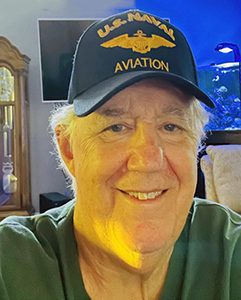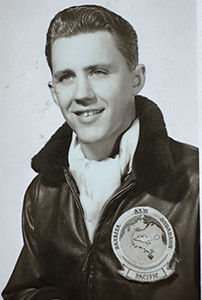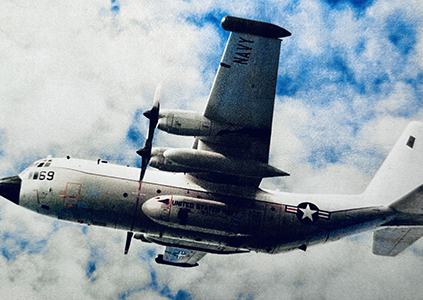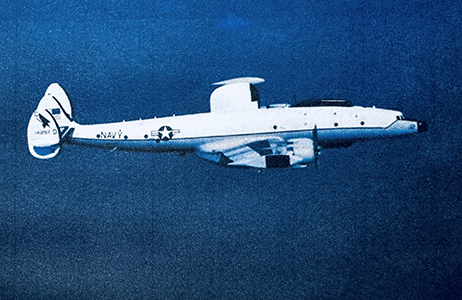Navy Vietnam War Hoffman Estates, IL Flight date: 09/25/24
By David Adams, Honor Flight Chicago Veteran Interview Volunteer
Ivan Lee White was born in 1943 while his dad served in the Army overseas. As he and his younger brother later learned, his dad fought in Europe with General George Patton’s Third Army. Ivan recalls that he admitted that he “worshiped the ground he [Patton] walked on.” Patton’s motto: “Let’s get it done”. He remembers some of his dad’s stories about fighting in the Battle of the Bulge. He left the Army at the end of the war but enlisted in the USAF several years later.
The family was living in Alaska at Ladd AFB in Fairbanks when in 1959 his dad was transferred to Francis E. Warren AFB, three miles west of Cheyenne, WY. Then and now a strategic missile wing is located there. His dad retired as a USAF NCO in 1966. Ivan finished his last two years of high school at Cheyenne Central High School, graduating in June 1961. He wanted to attend the Naval Academy and did secure a “first alternate appointment”. However, the primary appointee accepted and headed to Annapolis. “I was bound and determined to enter the Navy.” So he enlisted. As soon as he graduated high school on a Friday, the next Monday, June 22, 1961, he was off to San Diego for basic training. “I was chomping at the bit.” Growing up a “military brat”, he says, “traveling is in my DNA.” He would see a lot of the world during his two stints in the Navy.
Enlisted Navy electronics technician: 1961-65
Ivan completed basic training at San Diego Naval Training Center. From there he went to Millington, TN for basic electronics training and to Glencoe, GA for Basic and Aviation Electronic Technician training. He also underwent specialized training for the EC-130. By the end of April 1962 his training was complete and he was ready to join the fleet. He joined AEWBARRONPAC, the largest squadron in the Navy. For the next three years he flew airborne early warning flights from Midway NAS (Naval Air Station) to the Aleutian Islands in the WV-2 (EC-121) Warning Star Aircraft. He describes the aircraft as “a highly modified Constellation aircraft that was operated by TWA in the commercial world”. It incorporated, as he recalls, “both the APS-20 long range search radar and APS-45 height finding radar. . . [I] also worked at a plotting table and manned passive ECM Avionics”. The EC-121 itself had two large radomes, a vertical one atop the fuselage and a horizontal one below.
Home base for the squadron was Barbers Point, Hawaii. Ivan flew to Midway for his two weeks of “barrier flights” often to Kodiak or Adak. Then refuel and return. Each time he was at Midway he flew seven barrier flights. This operation supplemented the Distant Early Warning (DEW) line whose mission was to identify hostile aircraft headed for North America. A counterpart Navy operation flew over the Atlantic.
The squadron had in excess of thirty aircraft. According to Ivan an EC-121 launched every four hours for its 16-hour patrol. Four or five aircraft were kept airborne at all times. As Ivan describes it, if an unidentified aircraft was confirmed, the information was sent to Barbers Point for further processing. In three years with the squadron he logged more than 3,000 flight hours in the EC-121.
Ivan’s active-duty enlistment was up on May 6, 1965 as an ATW3 (E-4). Off to college he went.




College: 1965-68
After his four years in Navy service he managed to save enough money for a year of college. Quite a feat on a Navy seaman’s pay of $200 per month, the rate of pay in 1965. He enrolled in junior college in Sheridan, WY. At the end of his freshman year in spring of 1966 he learned that the G.I. Bill became available to him. Congress had just passed the Readjustment Benefits Act of 1966. His challenge to fund the remainder of college was solved. “Now I could go to school year-round”, and he did. Ivan graduated from Colorado State with a BA in 1968 after three years.
Navy pilot: 1968-77
“I had fallen in love with flying.” So he entered the Navy’s Aviation Officer Candidate School (AOCS) at NAS Pensacola, FL. School lasted 16 weeks. Each class had a Marine drill instructor. Strict does not describe the DI’s standards according to Ivan. Recall Sergeant Foley from the movie An Officer and a Gentleman. In January 1969 Ivan was commissioned an Ensign and headed to flight school.
Primary and Basic Flight School were conducted at NAS Pensacola. Ivan first flew the Beechcraft T-34B Mentor for basic skills including instrument flying. Then on to the North American T-28 “Trojan” for primary training. The T-28 syllabus required carrier qualification. First carrier landings were practiced on a replica carrier deck laid out on land. Next off to the carrier which Ivan says looks as small from overhead as everyone imagines. Achieving carrier qualification was the “highlight of my career”.
All pilots have “war stories” and Ivan is no exception. He tells about his T-28 carrier qualification as follows: “The flight for Carrier Qualification originated in Pensacola, two students flying T-28’s solo, and an instructor pilot in separate T-28 (first long cross-country.) We flew from Pensacola to NAS Jacksonville (JAX ), overnight [on base], and flew out to carrier the following day for quals. Back to NAS JAX, remain overnight and fly back to Pensacola the next day. My partner flew lead from Pensacola so he was responsible for Navigation. Coming back [to Pensacola], I flew lead. On return flight, thunderstorms were moving into JAX area and we had to leave in a hurry. In the haste to leave I had all my charts and publications in a bag I placed in storage space which was inaccessible in flight. Prior to leaving Pensacola a flight instructor had told me that anytime you do a cross-country always carry a standard road map in your flight suit leg pocket as a backup, for ‘just in case’ situations. I did just that and that road map was enough to get us back safely. Needless to say I never told the instructor. It was a VFR flight.”
His advanced flight training in the Grumman S-2 “Tracker” light twin airplane occurred at Corpus Christi, TX. He also needed to attain carrier qualification in the S-2, which he did on a carrier in the Gulf of Mexico. Ivan earned his pilot wings in late 1969. Upon graduation and being in the Navy’s “blow back” program he was committed to serve as a pilot training instructor in the T-34 at Pensacola. His flight instructor’s assignment was completed in early 1972.
Ivan’s next assignment was to VQ-3 on NAS Agana, Guam flying the EC-130Q Hercules. He transitioned to flying the EC-130 after he arrived at the squadron. It was a component of TACAMO (Take Charge And Move Out). As squadron history states it served as a system of survivable communications links designed to be used in nuclear warfare to maintain communications between the decision-makers such as the President and attack submarines patrolling the Pacific.
Ivan calls it a “spooky operation”. Communications in back of the plane provided an alternate means to issue launch signals to nuclear subs submerged in the Pacific Ocean. On any sortie the EC-130 flew a random track within a 10,000-foot altitude block. The transmitted radio signals were in the VLF range and made only one-way to the sub. No reply was expected or would be made to launch signals. Transmissions were via a trailing copper wire cable antenna extending from the back of EC-130. As the cable was reeled out of the airplane, Ivan flew in a constant bank of about 30 degrees. This maneuver allowed the cable/antenna to make a large spiral, hence the altitude block needed. Attached to the end of the cable was a device designed to keep it straightened out. Ivan describes it as follows: “Think of a cone with the top cut off. The antenna wire attached at the small top area of the cone and when deployed the cone/drogue actually acted like an airfoil and, “flew,” in addition to putting weight at the bottom of the wire much like a weight attached to the end of a fishing line. It looked like a traffic cone you see on roads where maintenance is being performed only a bit larger at the bottom.” Infrequently the wire cable could ice up causing it to become very heavy and affect the flight stability of the airplane. If necessary, the crew could “guillotine” the wire to save the airplane. Back to base for another cable.
Invariably Ivan has another war story: “I was on a TACAMO flight north of Saipan in the EC-130 transmitting VLF traffic to Nuke Subs. A Russian Bear Bomber flew over us about 1000’. I was in the back of the aircraft at the time but it was reported up the chain of command. Never heard any more about it. Think the Russkies just wanted to say, we know where you are and what you are doing.”
From time-to-time he flew his EC-130 at night into Cam Rahn Bay, Vietnam, toward the end of the war. He parked in a remote area of the field where a ground crew loaded cargo in the guise of military coffins. He never learned their secret contents. The “coffins” were delivered to whichever American facility he was directed.
His last assignment was a recruiter in Dallas, TX from 1975-1977. Both recruiters were pilots. They had access to a T-34 which they flew to various colleges and universities for recruitment purposes. He liked the “flying an airplane part” but not so much the “flying a desk” part. He resigned his commission in March 1977 receiving an honorable discharge following 12 years of active Navy service. Leaving as a Navy Lieutenant (O-3) his decorations include a Meritorious Unit Commendation and the National Defense Ribbon.
While in Dallas and before he left the Navy he obtained his ATP (Airline Transport Pilot) rating. He obtained a Certified Flight Instructor (CFI) certificate after he moved to Chicago in 2004. For a time he offered flight instruction at flight schools.
From 1977 to the late 1990s he flew for a variety of foreign-flagged air carriers in Saudi Arabia and Japan. He and his family returned to the States eventually settling in the Chicago area. Being a skilled artist in drawing and painting, he exhibited his works while living in Japan. Today he works in his home studio solely for pleasure. Although, if you see something you like, make him an offer!
Ivan has two sons, two daughters. and three grandchildren: two girls and a boy. He and his wife spend as much time as possible with them. Their winters are spent in Sarasota, FL.
Ivan you have earned your day of honor in Washington, D.C. Do enjoy it thoroughly.


